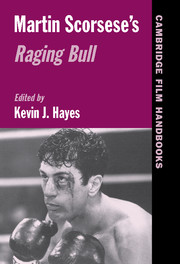Book contents
- Frontmatter
- Contents
- List of Illustrations
- List of Contributors
- Abbreviations
- Introduction: The Heritage and Legacy of Raging Bull
- 1 Art and Genre in Raging Bull
- 2 Visual Absurdity in Raging Bull
- 3 Raging Bull and the Idea of Performance
- 4 Women in Raging Bull: Scorsese's Use of Determinist, Objective, and Subjective Techniques
- 5 My Victims, My Melancholia: Raging Bull and Vincente Minnelli's The Bad and the Beautiful
- REVIEWS OF RAGING BULL
- Filmography
- Select Bibliography
- Index
1 - Art and Genre in Raging Bull
Published online by Cambridge University Press: 24 November 2009
- Frontmatter
- Contents
- List of Illustrations
- List of Contributors
- Abbreviations
- Introduction: The Heritage and Legacy of Raging Bull
- 1 Art and Genre in Raging Bull
- 2 Visual Absurdity in Raging Bull
- 3 Raging Bull and the Idea of Performance
- 4 Women in Raging Bull: Scorsese's Use of Determinist, Objective, and Subjective Techniques
- 5 My Victims, My Melancholia: Raging Bull and Vincente Minnelli's The Bad and the Beautiful
- REVIEWS OF RAGING BULL
- Filmography
- Select Bibliography
- Index
Summary
Genre films are based upon a shared formula, conventions that are subconsciously recognized by audiences and filmmakers. Repetitive genre patterns are often understood to be contrary to the originality, complexity, and intensity characteristic of high art. Indeed, the European “art” cinema has often been distinguished from Hollywood productions because it turns from genre conventions and presents films with a greater emphasis on social realism, the psychological development of characters, self-conscious style, and a cultivated ambiguity.
Paradoxically, many of the most celebrated cinematic achievements of Hollywood filmmaking are vividly realized genre films. Many classics of the studio era, such as Trouble in Paradise (1932), The Big Sleep (1946), and Vertigo (1958), were recognized as little more than generic entertainments at the time of their release. Even films from the “Hollywood Renaissance” influenced by the European art cinema, such as 2001: A Space Odyssey (1968), The Godfather (1972), and Chinatown(1974), found their base in genre films. Noël Carroll, among others, has written of the two-tiered address of such classics – the obvious level of incident, character, and sensation engaging a mass audience, while the more subtle development of implicit themes and stylistic patterns is understood by the attentive film enthusiast.
Raging Bull arises from this Hollywood tradition of using genre to construct a work that realizes ambitious aesthetic goals. By contrast with Raging Bull, Fat City (1972) is a Hollywood boxing film that avoids genre conventions and builds its artistic sensibility upon its literary source.
- Type
- Chapter
- Information
- Martin Scorsese's Raging Bull , pp. 19 - 40Publisher: Cambridge University PressPrint publication year: 2005
- 3
- Cited by



